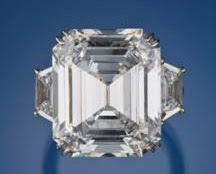 |
| The 18.70 carat emerald cut diamond in this ring is flanked by two rhomboid-shaped side stones. Image ©GIA. |
The Gemological Institute of America, creator of the “4Cs,” has provided some basic tips on how to shop for diamonds. They are as follows:
1. Learn about what you’re buying: Today’s consumers are savvy about researching what they want. Most start by learning about GIA’s 4Cs of diamond quality (Color, Cut, Clarity, Carat weight), which makes it easier to talk about diamonds with jewelers and to compare quality with pricing.
2. Understand how gemstone quality is determined: The 4Cs establish the diamond’s overall quality and value.
- Carat weight: Diamonds are weighed in metric carats. Just as a dollar is divided into 100 pennies, a carat is divided into 100 “points,” so a 50 point diamond is 0.50 carats.
- Clarity: Nearly all diamonds contain unique clarity characteristics that are usually invisible unless magnified at least 10 times. Flawless diamonds are extremely rare and highly valued.
- Clarity: Nearly all diamonds contain unique clarity characteristics that are usually invisible unless magnified at least 10 times. Flawless diamonds are extremely rare and highly valued.
- Cut: Cut refers to proportion, not shape, and pertains to the number, placement and shape of the facets used to create the finished diamond. Light bounces off the facets of a well-cut, balanced diamond to reflect and magnify its color and sparkle.
3. Choose a qualified jeweler: Consumers should select a jeweler as carefully as their doctor, lawyer or other trained professional. Find someone trained as a gemologist, such as a GIA Graduate Gemologist. Look for affiliations with jewelry industry groups and professional associations.
4. Ask for an independent diamond grading report during the shopping process: This not only provides an impartial opinion of the diamond’s quality, but also serves as an identification document if the stone is lost or stolen. The GIA Diamond Grading Report includes an assessment of a diamond’s 4Cs, a plotted diagram of its clarity characteristics and a graphic representation of its proportions. Jewelers commonly rely on grading reports when buying gemstones for their business, so the stature of the report that accompanies a stone can say a lot about how careful the retailer is about accuracy when selecting merchandise.
5. Keep the purchase secure: Get the diamond appraised and insured. A grading report is a gemological blueprint and an independent assessment of a diamond’s quality; an appraisal assesses a monetary value.
And while diamonds remain the gemstone of choice for the most important jewelry purchases, GIA notes that colored gemstones surged in popularity when Prince William popped the question to Kate Middleton with Princess Diana’s blue sapphire and diamond engagement ring.
The Gemological Institute of America, an independent nonprofit organization established in 1931, is recognized as the world’s foremost authority in gemology. GIA invented the 4 Cs of Color, Cut, Clarity and Carat Weight in the early 1950s and in 1953, created the International Diamond Grading System which, today, is recognized by virtually every professional jeweler in the world.





